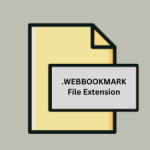.CSS File Extension

What is an CSS file?
The .CSS file extension stands for Cascading Style Sheets, which are used to define the presentation of web pages.
This includes the layout, colors, fonts, and overall aesthetic of a site. CSS files are essential for web design, providing a way to separate content from presentation, allowing for a more streamlined and efficient way to maintain and update the visual aspects of a website.
More Information.
CSS was first proposed by Håkon Wium Lie on October 10, 1994. At that time, the primary purpose of CSS was to allow web developers to separate content from design, which was previously mixed within HTML files.
Before CSS, designers used HTML tags like <font> and <table> to control the layout and style of web pages, which led to cumbersome and hard-to-maintain code.
CSS provided a cleaner, more efficient way to style web pages by linking a single CSS file to multiple HTML pages, enabling consistent styling across an entire site.
The first official specification, CSS Level 1, was released by the W3C in December 1996. This initial version included fundamental features such as fonts, text properties, color, background, and spacing.
Since then, CSS has evolved significantly, with new levels and modules added to enhance its capabilities.
Origin Of This File.
The origin of CSS files dates back to the early days of the internet. As web pages became more complex, the need for a standardized method to manage the visual elements of web pages grew.
The World Wide Web Consortium (W3C), the main international standards organization for the internet, introduced CSS to address this need.
File Structure Technical Specification.
A .CSS file consists of a series of rules that define how HTML elements should be displayed. Each rule has a selector and one or more declarations. The selector targets the HTML elements to be styled, while the declarations specify the style properties and values.
- Selectors: Determine which HTML elements the style rules apply to. For example,
bodyapplies styles to the<body>element, andh1applies styles to all<h1>elements. - Declarations: Enclosed within curly braces
{}, each declaration consists of a property and a value, separated by a colon. For example,background-color: #f0f0f0;.
How to Convert the File?
While .CSS files are typically used directly in web development, there may be instances where conversion to another format is necessary.
For example, CSS can be converted to a style format in another language (e.g., inline styles in an HTML document).
Tools for Conversion:
- Preprocessors: Tools like Sass and LESS allow for the conversion of preprocessor files (.scss or .less) into standard CSS.
- Online Converters: Websites such as CSS2LESS or SASSMeister can convert CSS to LESS or Sass formats.
- Text Editors: Any text editor can be used to manually convert or reformat CSS code.
Advantages And Disadvantages.
Advantages:
- Separation of Concerns: CSS separates content from presentation, making HTML cleaner and more readable.
- Reusability: CSS rules can be reused across multiple HTML pages, reducing redundancy and saving time.
- Maintenance: Site-wide changes can be made quickly by editing a single CSS file.
- Consistency: Ensures a consistent look and feel across different web pages.
- Accessibility: Helps in creating accessible web designs that can be adapted for different devices and user needs.
Disadvantages:
- Complexity: Large and complex stylesheets can become difficult to manage.
- Browser Compatibility: Different browsers may interpret CSS differently, leading to inconsistent presentation.
- Performance: Extensive use of CSS can impact page load times, especially with large files.
How to Open CSS?
Open In Windows
- Notepad: The built-in text editor can open and edit CSS files.
- Notepad++: A free, powerful text editor that offers syntax highlighting and other features for CSS.
- Visual Studio Code: A popular code editor with extensive support for CSS through extensions.
Open In Linux
- Gedit: The default text editor for the GNOME desktop environment, supports syntax highlighting for CSS.
- Kate: A powerful text editor for KDE with extensive support for various programming languages.
- Visual Studio Code: Also available on Linux, offering a consistent experience across operating systems.
Open In MAC
- TextEdit: The default text editor for macOS can open CSS files in plain text mode.
- BBEdit: A professional text editor with advanced features for web development.
- Sublime Text: A versatile and highly configurable text editor favored by many developers.













